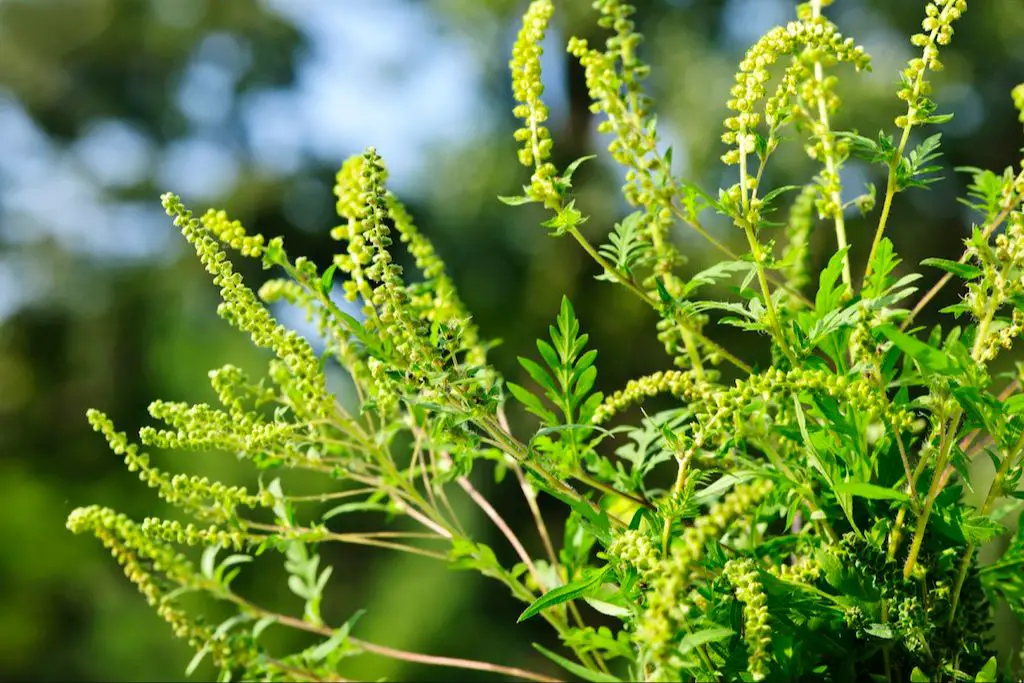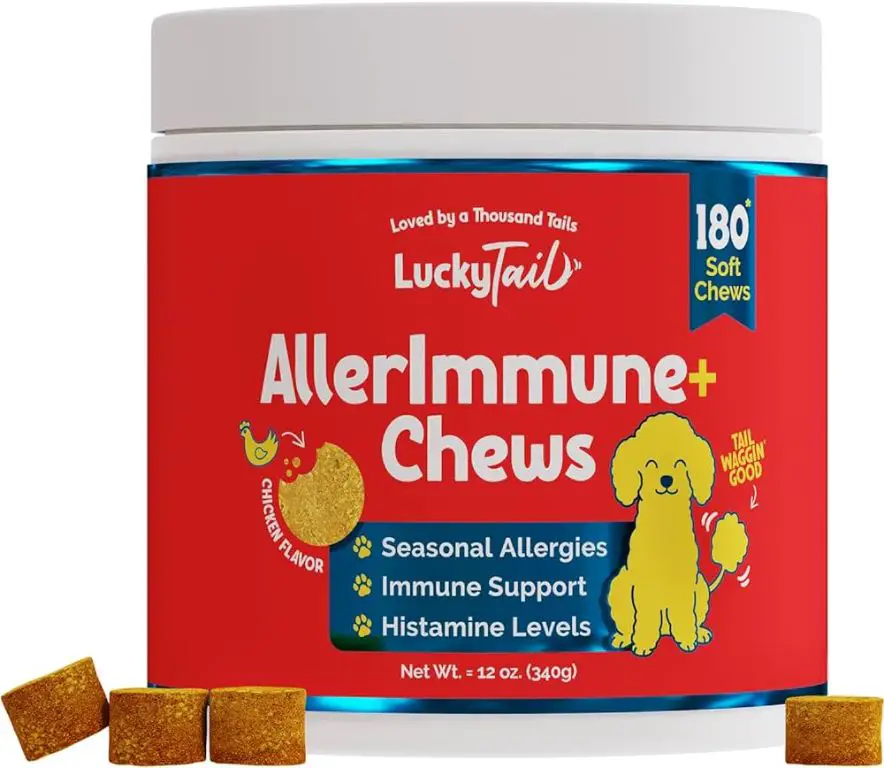What is dog fennel?
Dog fennel (Eupatorium capillifolium) is a perennial herbaceous plant in the Asteraceae family. It is native to the eastern and southcentral United States. Dog fennel grows 2-4 feet tall and has fragrant fern-like leaves and small white flower heads that bloom in late summer to early fall.
The scientific name Eupatorium comes from Mithridates Eupator, King of Pontus, who was said to have used these plants for medicine. The species name capillifolium refers to the hairy, threadlike leaves.
Dog fennel is found in dry, open areas like fields, roadsides, and vacant lots. It thrives in sandy or rocky soils and spreads aggressively via rhizomes. While often considered a weed, dog fennel has some uses as an herbal remedy, insect repellent, and nectar plant for pollinators.
Dog fennel pollen as an allergen
Dog fennel is a wind pollinated plant that produces copious amounts of pollen grains during its flowering season. This lightweight and dry pollen can become easily airborne and spread widely by wind currents. Compared to insect pollinated plants, wind pollinated species like dog fennel tend to generate much higher quantities of pollen grains in order to increase the chances of pollination.

For people sensitive to certain pollen, dog fennel can be a significant allergen. Pollen grains can trigger allergic reactions when they come into contact with the eyes, nose, and upper airways. The pollen causes the immune system to overreact, resulting in common hay fever symptoms like sneezing, itchy eyes, congestion, and runny nose. Dog fennel pollen is light and easily dispersed by wind, allowing it to travel many miles from the original source. This makes avoidance difficult for sensitive individuals.
The tiny size of pollen grains, usually between 5-100 microns, also enables them to penetrate deep into the respiratory tract. In addition, the outer coatings of pollen contain allergenic proteins that provoke immune responses. Dog fennel produces large volumes of pollen over a period of several weeks, increasing allergen exposure. For those predisposed to dog fennel pollen, it can be a significant seasonal trigger for allergy and asthma flares.
Symptoms of dog fennel allergy

Some of the common symptoms associated with dog fennel allergy include:
Runny nose and sneezing – Dog fennel pollen can cause the nasal passages to become irritated and inflamed, leading to excessive mucus production and sneezing fits. The nose may run constantly like a faucet.
Itchy eyes – The pollen irritates the membranes of the eyes, causing redness, watery eyes, and intense itchiness. Rubbing the eyes excessively is common.
Asthma attacks – Inhaling the pollen can trigger bronchial constriction and asthma symptoms like wheezing, coughing, shortness of breath, and tightness in the chest. Asthma attacks from dog fennel can range from mild to severe.
In addition to these primary allergy symptoms, some individuals may experience hives, rashes, sinus congestion, headache, and fatigue when exposed to dog fennel pollen.
Cross-reactivity with other plants
Dog fennel pollen is closely related to ragweed pollen. For those with ragweed allergies, exposure to dog fennel may trigger an allergic reaction due to cross-reactivity between the plant pollens. Both plants belong to the Asteraceae/Compositae family, sharing similar proteins that can cause IgE antibodies to bind and trigger allergic symptoms.
There is also some evidence that dog fennel pollen may cross-react with chrysanthemum pollen in sensitized individuals. Chrysanthemums belong to the same plant family and contain similar allergenic proteins. People with dog fennel allergies may want to avoid exposure to chrysanthemums to reduce risks of a cross-reaction.
Prevalence of dog fennel allergy
Dog fennel allergy is relatively common, affecting around 15-20% of people with seasonal allergies. Those living in areas where dog fennel grows are at the highest risk of developing an allergy. This includes much of the southern and southeastern United States where dog fennel thrives in the warm, humid climate.
Children and young adults are more prone to dog fennel allergy than older people. Around 30% of children with seasonal allergies test positive for sensitivity to dog fennel pollen. Rates are lower in the overall population since tolerance can develop over time. Gender also plays a role, with dog fennel allergy being about 25% more prevalent in boys and men.
People with asthma or atopic dermatitis have an increased likelihood of reacting to dog fennel as well. Exposure to the pollen at a young age raises the risk of becoming sensitized. Those with relatives who suffer from dog fennel or other pollen allergies are also more susceptible due to a genetic component.
Seasonal Nature of Dog Fennel Pollen
Dog fennel pollen levels tend to peak in late summer and early fall. The highest concentrations usually occur between August and October in most regions. This coincides with the typical blooming period for dog fennel plants.
There can be some variation across different geographical areas. For example, in southern states like Florida and Texas, dog fennel may start releasing pollen as early as July. Meanwhile, more northern states may not see peaks until September or October. Dog fennel also blooms later at higher elevations.
In general, coastal regions experience earlier and longer dog fennel pollen seasons compared to inland areas. Urban environments also tend to have higher pollen counts that persist over longer periods versus rural locales.
Paying attention to historical pollen count trends and forecasts for your specific area can help allergy sufferers predict and prepare for times of high exposure risk.
Diagnosing dog fennel allergy
There are a few methods allergists use to diagnose a dog fennel allergy:
Skin prick testing – This is the most common allergy test. A dilute extract of the suspected allergen, in this case dog fennel, is placed on the skin and pricked. If you’re allergic to it, a small, itchy red bump will appear within 15-20 minutes.
Blood tests for IgE antibodies – A blood sample can be analyzed to measure your levels of immunoglobulin E (IgE) antibodies specific to dog fennel pollen. Higher levels indicate an allergy.
Nasal provocation testing – Using a dilute extract of dog fennel pollen, your allergist places drops in your nose to observe your reaction. Swelling of the nasal tissue indicates allergy. This method is not frequently used.
Treatment Options for Dog Fennel Allergy

There are several treatment options that can help relieve the symptoms of a dog fennel allergy:
Antihistamines
Antihistamines like cetirizine (Zyrtec), loratadine (Claritin), or fexofenadine (Allegra) can help reduce allergy symptoms like sneezing, runny nose, and itchy eyes. Antihistamines work by blocking the effects of histamine, the chemical the body releases when having an allergic reaction. Most antihistamines are available over-the-counter.
Nasal Corticosteroids
Nasal corticosteroid sprays like fluticasone (Flonase) and triamcinolone (Nasacort) can reduce inflammation in the nasal passages. They can help relieve sneezing, runny nose, nasal itching, and congestion. Nasal corticosteroids are available by prescription.
Allergy Shots
Allergy shots, also known as immunotherapy, can help desensitize your body’s immune system to dog fennel pollen over time. Injections contain small amounts of dog fennel extract. Over the course of treatment, the doses are gradually increased. This exposes the immune system to the allergen to develop immunity or tolerance. Though it takes time to work, allergy shots can provide long-lasting relief of allergy symptoms.
Nasal Sprays and Eyedrops
Nasal sprays like azelastine (Astelin) and olopatadine hydrochloride (Patanase) can help relieve nasal symptoms. Eyedrops like olopatadine (Pataday) and epinastine (Elestat) can reduce itchy, watery eyes. Both prescription nasal sprays and eyedrops can be used along with oral antihistamines.
Prevention Tips
If you suffer from dog fennel allergy, there are some steps you can take to minimize your exposure and reduce symptoms:
Minimize exposure during high pollen times – Dog fennel pollen levels peak in late summer and early fall. During this time, try to limit your time outdoors or take precautions. Track pollen counts in your local area and adjust plans if counts are very high.
Keep windows closed, use AC – When pollen counts are high, keep windows shut at home and in your vehicle. Run the AC with a clean cabin air filter to reduce indoor allergens.
Shower after going outside – Pollen can collect on your hair and clothing when outside. Take a shower and change clothes after spending time outdoors during pollen season.
By monitoring pollen forecasts and taking simple precautions, people with dog fennel allergy can often reduce their exposure and keep symptoms in check during peak season.
Outlook for dog fennel allergy sufferers

The outlook for people with dog fennel allergies can vary depending on the severity of their symptoms. While dog fennel allergies may not be life-threatening, they can significantly impact quality of life if not properly managed.
Compared to more common environmental allergies like dust mites or pollen, dog fennel allergies are relatively rare. However, for those who have dog fennel sensitivity, the effects can be quite disruptive during peak pollen seasons. Symptoms like sinus congestion, itchy eyes, coughing, and sneezing can persist for weeks or months at a time when dog fennel is blooming.
The good news is that with proper diagnosis and treatment, most people can effectively manage their dog fennel allergies. Avoiding exposure, taking medications, and undergoing immunotherapy can help minimize symptoms and allow patients to live active, healthy lives. While dog fennel allergies may be frustrating to deal with, they do not have to dramatically reduce quality of life with the right treatment approach.